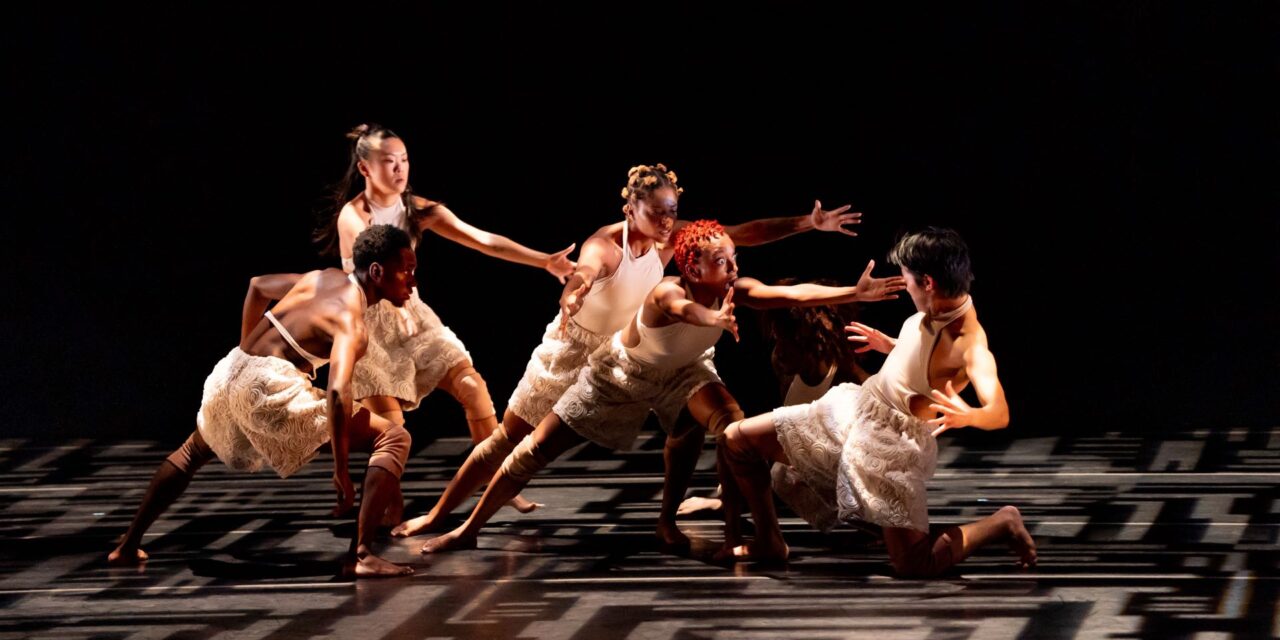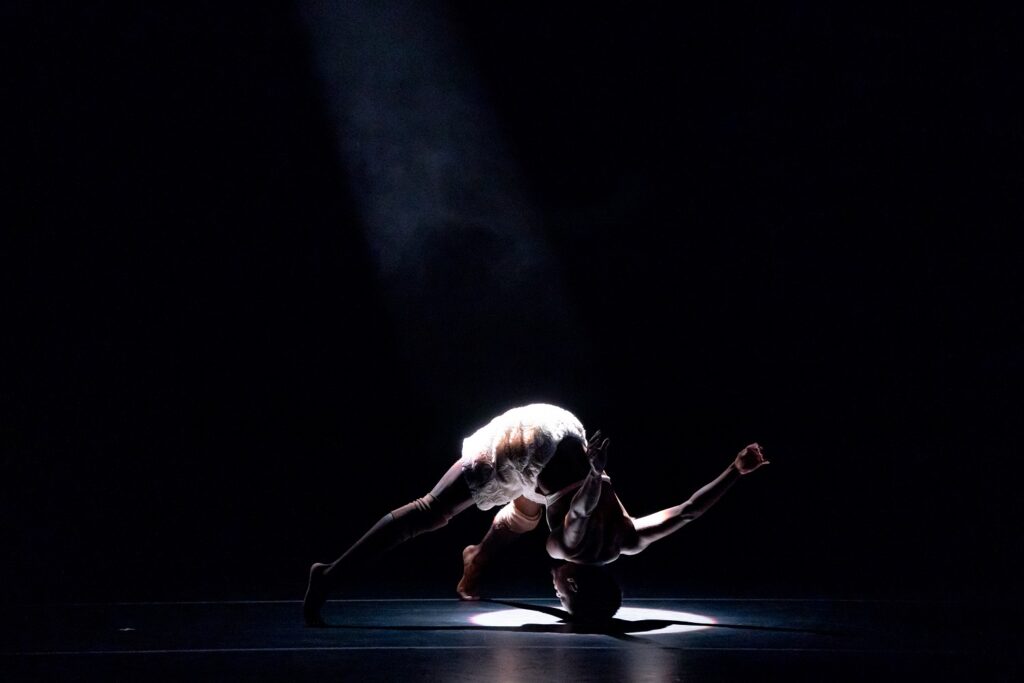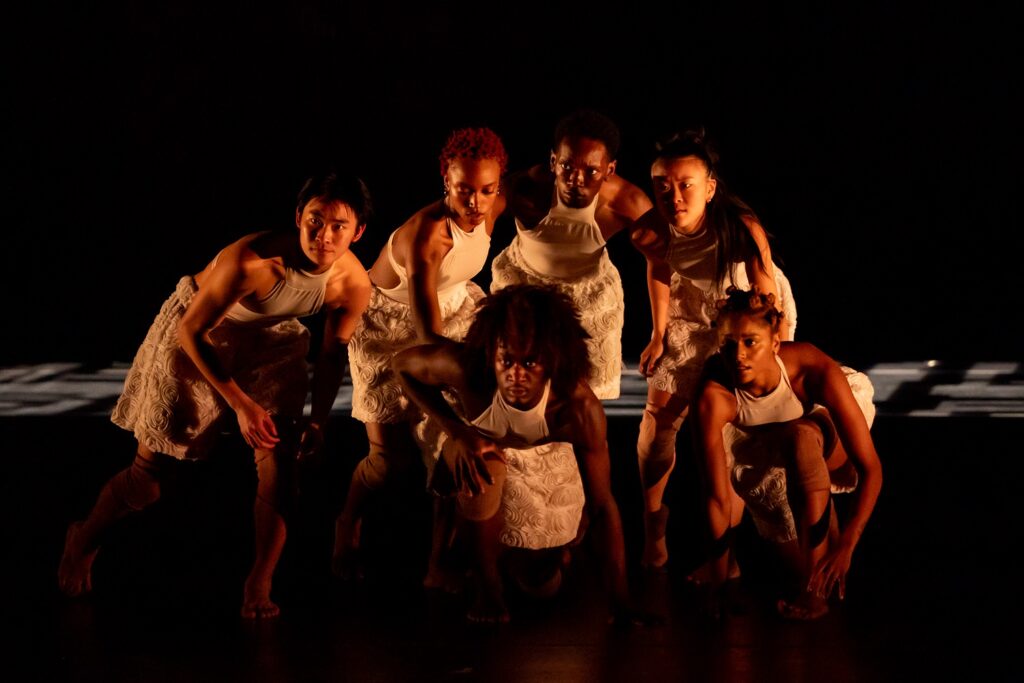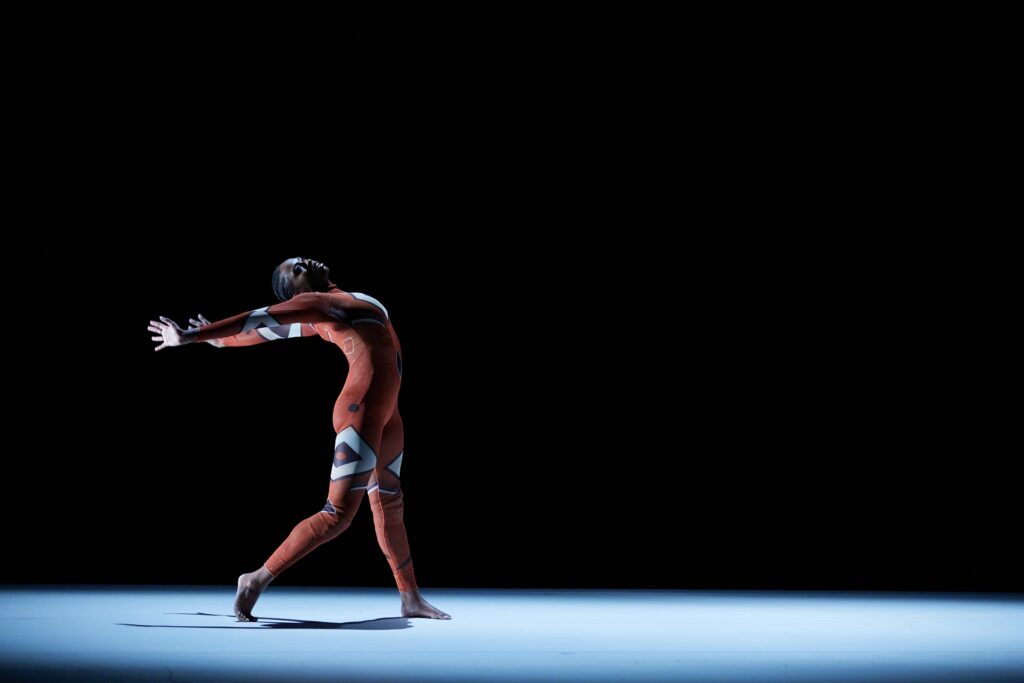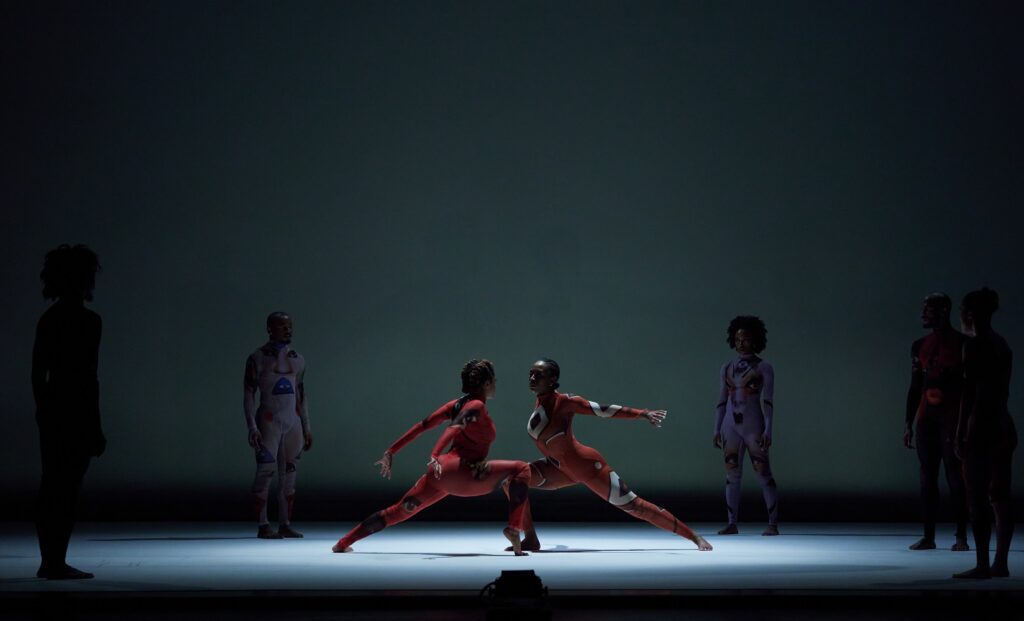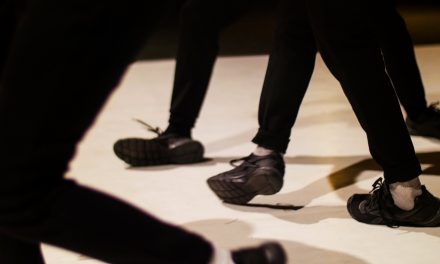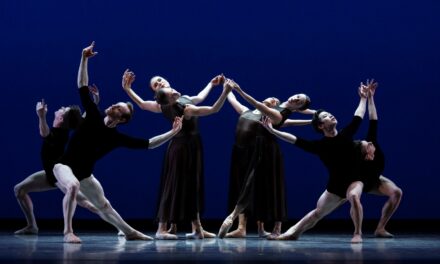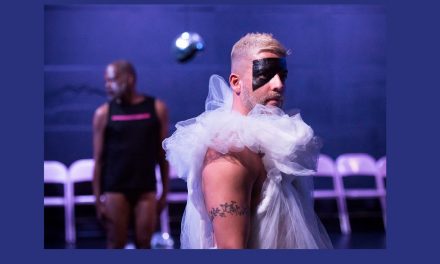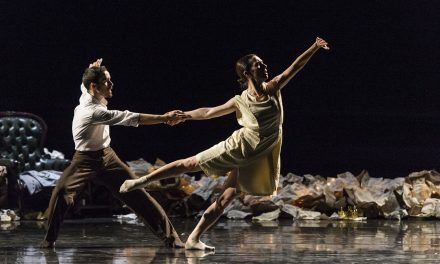Dancer William Okajima tips, crumbles and picks himself back up again. In quick spurts, he slithers through his spine as if trying to pull something out of his body. A line of dancers stands behind him. As he breaks the mold, so do the ensemble. Once out, the lights shift, and the world erupts.
A.I.M by Kyle Abraham’s presentation at The Wallis in Beverly Hills from April 11 – 12 centered on evolution and rebuilding in four works. “Shell of A Shell of The Shell” by Rena Butler revisits and decolonizes the narrative of “King Kong.” “Just Your Two Wrists,” a solo by Paul Singh, evokes feelings of extension and recovery with each step. Abraham’s “2×4” is packed with “geometrical playfulness” meant to promote community and connection among the quartet. “Year” by Andrea Miller, in collaboration with A.I.M, immerses performers into a sci-fi world where each dancer’s body and presence move the ensemble forward. Each work shimmers with intention and wonder for the art of dance.
Butler’s piece balances ensemble sections with solos or duets that allow for a deeper dissection into the psyche. The work peels back the layers, depicting each level with canon movements by Jamaal Bowman, Alysia Johnson, Okajima, Donovan Reed, Keturah Stephen and Olivia Wang. The use of each one slingshots the dancers into a new moment with passion. Lighting design by Dan Scully helps highlight each layer by giving the soloists a spotlight to dramatize the relationship between the dancers and the audience.
In a pivotal shift, the dancers sway in front of a bright light on the entire back wall of the stage. The creative choice turns the dancers into shadows, lurking and faceless. It unearths a sense of anonymity and transformation. The bodies are unidentifiable. As they collide, the audience must accept that they can’t look at the steps or the limbs. It is an evolving amoeba. Finally, they expose themselves and the audience. The ensemble walks upstage, and the lights go up in the theater. They look out at the audience, expressionless. It is an act of witnessing. Butler’s choice is strong. In a piece dedicated to recontextualizing a character like King Kong, the act of being seen promotes a sense of belonging. The dancers are not distant or on a stage to entertain. They want to be seen. As they turn back to complete the piece, their movement feels more visceral because the distance between the audience and the performer has been broken. You are now part of the act.
Singh’s “Just Your Two Wrists” is quick, both in its content and temporality. It captures the breath. Soloist Amari Frazier swings the legs and arms in large, broad movements before shifting to smaller ones that feel more internally motivated. Singh makes the most of each second, ensuring that the moments of stillness are worth it. Each reach and crumble finds a moment to pause and reach further or crumble deeper. The final step is the most rewarding. The piece set to “just (after song of songs),” composed by David Lang, recites, “Just your flock. Just your companions. Just your kids…” The list goes on. Singh embodies this constant build until the last statement. Frazier reaches his wrists up in the air, inches away from each other. There’s only a second left. He stretches further. The lights go out.
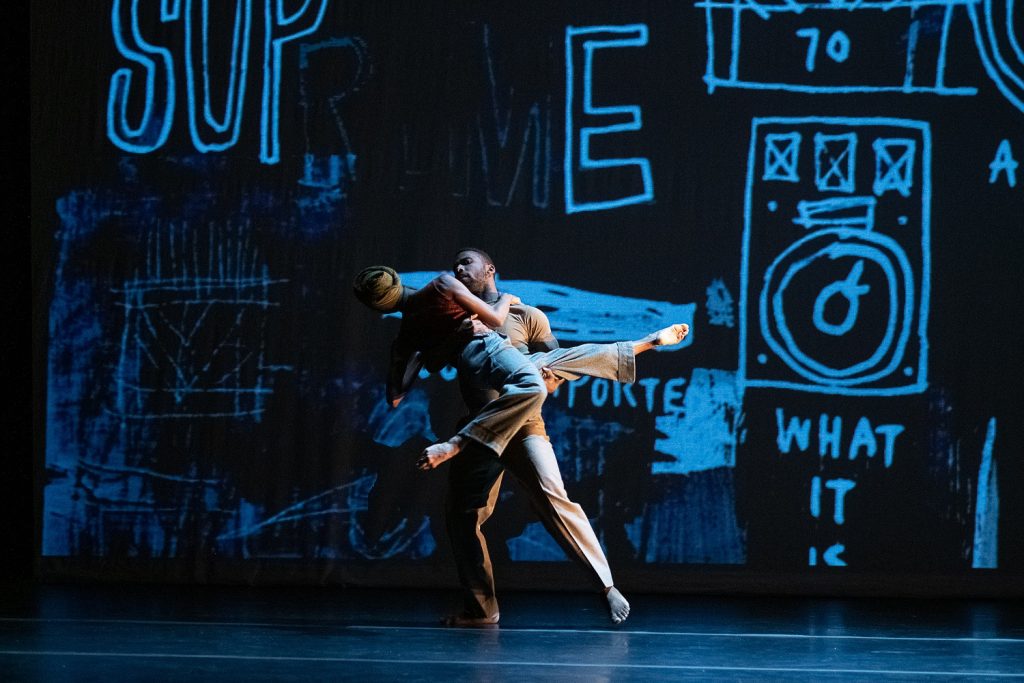
A.I.M. by Kyle Abraham – Tamisha A. Guy and Claude “CJ” Johnson in “An Untitled Love” – Photo by Christopher Duggan
Abraham’s “2×4,” created in collaboration with the company, is a more modern piece. The modern side of the work allows for geometric structure in the body. Angles of the limbs are emphasized in each turn or relevé. However, it isn’t completely firm. Abraham infuses the modern inspiration with a gooey center. Mykiah Goree, Okajima, Morgan Olschewske and Reed weave into separate pairings. They find ways of giving a bit of themselves to the other person, but not in the physicality of the piece. The performers look at each other during each phrase. It can be quick or lingering, but it is there. The look is one of compassion. It’s a quick, “I got you,” before they fall to the side or pivot. Sometimes there’s a smile. Here, Abraham challenges what support looks like in a dance piece.
The music by Shelley Washington incorporates brass instruments that has a beautiful shrill. The choreography takes note of this by pairing the typical modern and balletic steps with Abraham’s “Kyle-isms” and subtleties. The arms swing over the head and shape the air in a way that resembles the instrument’s melody. It captures the note and lets it move the hand or arm forward. And when the music trembles, so do the hands. Dancers shake their stiff, outstretched hands like a fluttering wing, bringing you to pay attention to the details of the music.
Lastly, Miller’s “Year” transports the performers — Bowman, Frazier, Goree, Faith Joy Mondesire, Reed, Keturah Stephen, Dianna Theodore and Wang — to an otherworldly environment. The scenic design by Miller and Dan Scully sets the group under a red sun, entrapped by white walls. Mondesire opens the piece with a solo that cements the otherworldly tone. She sinks into the movement and makes it her own. She finds quick embellishments in the wrist or in the head that takes the choreography to the next level. It’s like adding her signature to the work.
The choreography mixes the ethereal with the tangible. While it is exciting to see a profound step, Miller’s work also finds pleasure and grace in the pedestrian and simplistic. In unison, the ensemble will fall into a groove, stepping and rocking to the music. These moments tighten up the group before seeping into the next scene. The choreography also contains gorgeous quirks that are unexpected yet brilliant. Rather than an elegant extended finger, Miller opts for a fist during steps that emphasize the structure of the body. It creates tension for the viewer and the dancer. Then there are the steps that begin pedestrian and slip into an exaggerated dance. One dancer swung their arm as if throwing a ball. They let the movement continue as their eyes move to the ground.
Reed stands out in the work. Their solo claws at the soul. After a phrase of dynamic movement, they plead. They bring their hands to the audience, arms stretched taut. They look out and shuffle forward. It’s as if pleading to be seen. The dance is dramatic and big. They land and stretch their arms out again to a new audience section. It’s visceral to watch. It’s all about presence and power. The solo calls for people to meditate on the hands spread in front of them and the effort of dance.
A.I.M’s presentation demands attention. The company proves time and time again that it has the caliber to captivate with its intimate dissection and revitalization of dance. However, this time around, they sought to remind viewers that they, too, are part of the equation. Dance is meant to be felt, and to feel, one must be present. As the dance artists rebuilt and evolved on stage, a vibrational call resounded out of the steps: Are you seeing this?
To learn more about A.I.M by Kyle Abraham, please visit their website.
To learn more about The Willis, please visit their website.
Written by Steven Vargas for LA Dance Chronicle.
Featured image: A.I.M by Kyle Abraham – “Shell of A Shell of The Shell” by Rena Butler – Photo by Cheryl Mann.

